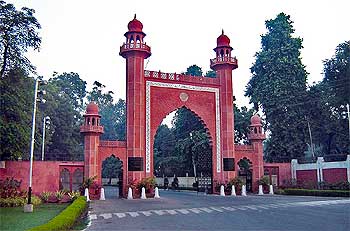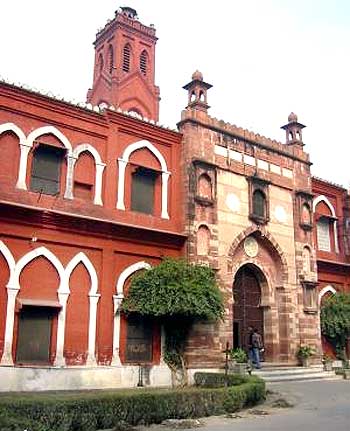
The Aligarh Muslim University is once again closed sine die. Students erupted in protest on October 26, following the killing of a student outside the campus the night before.
As about almost every previous agitation/forced closure, the latest campus closure that began on October 31 is also sine die.
If assured of anonymity, most insiders, would share the 'secret' that the student agitation at AMU is the result of "fierce rivalry between the warring groups of teachers."
The turmoil and agitation on the AMU campus is sadly a recurrent phenomenon, which makes it a focus of controversy. It can only be understood by dissecting the politics of internal power struggle at AMU.
Does it have anything to do with: a. the 'enormity' of the size of the boarding students? (Of over 32,000 students, about 17,000 live in hostels, probably the biggest residential 'one-campus' university); b. form and content of teaching, which does not help students in developing critical, questioning capabilities and abhorring all kinds of chauvinist worldviews; c. Recruitment/promotion policy; d. admission policy; e. lethargic, biased, weak, inefficient, corrupt administration?
Quite often, student agitations in AMU are believed to be engineered by one or the other group of 'politicking' teachers. Niraj Roy, in a different context in 1981, had precisely said the same thing that the AMU students are the 'pawns of the self-seekers'.
Urdu periodicals, memoirs/autobiographies (mostly of insiders) have a great many interesting and revealing details, pertaining to the affairs of AMU through the ages.
Vested interests:
As rightly observed by an alumnus and distinguished IAS officer, local factors, particularly vested petty interests, have always played a major de-stabilising role in the affairs of the university.
This time, the factionalism and polarisation have become even more evident in various meetings of the executive council, practically the highest decision-making body of AMU, which has 26 members, of which a good number is ex-officio, 'handpicked' by the vice-chancellor, the rest is nominated by the Centre.
Only four are directly elected by teachers: two by the lecturers, and the remaining two by the readers and professors jointly.
Are the factions really concerned about corruption in administration or they are fighting for their own shares/kickbacks in the contracts for constructions and purchase? It is necessary to probe this question.
The ongoing enquiry by the committee, led by Justice Fakhruddin, may probably examine it. This is also almost a pattern in the history of AMU that allegations, counter-allegations and exposes of corruption often accompany turmoil, indiscipline and upsurges.
This 'hypothesis' is exemplified, among few others, by the Shaikh Abdullah Committee Report (1926) and consequent the Ibrahim Rahimatoola Committee Report (October 1927), the AMU Official Enquiry Report (1961, was it called the Chatterjee Committee?), the Justice Mathew Report (1998, made public only in March 2007, and taking no action against those indicted) and the ongoing Justice Fakhruddin Committee (2009).

Is there really a link between the 'discomfiture' of teachers/officers and those of the students?
Insiders would answer in the affirmative. Arguably in AMU there has never been a student movement (let alone its autonomous character) of long-term vision and dynamics, not even on the issue of 'minority status' during 1965 to 1981.
There have only been sporadic, spontaneous, short-lived protests, and relief distribution among Muslim victims of communal riots, at times inviting allegations of embezzlement of the relief fund by office-bearers of the students union. Besides, some outbursts on emotive issues like the Muslim personal law, Urdu and the Babri Masjid.
Quite often, replacement of some teacher-administrators was the only important demand of the agitating students.
They, however, hardly demand any change in the principles and style of functioning of administrators. In the early 1990s, this phenomenon had become much recurrent when the pliant vice-chancellor invariably succumbed to the demands of student leaders whose influence on and accessibility to the VC (and other high functionaries) had reached such a menacing limit that the student leaders could decide the recruitment/promotion of the teachers, teacher-administrators and other functionaries.
These 'observations' may not tell us everything we want to know, but they do illustrate some critical features in which the system called AMU works.
Isolation Syndrome
In the 1960s and subsequent decades, most campuses were agitating on issues like unemployment, rural poverty, economic inequality, land reforms, atrocities against Dalits and minorities, social justice and civil liberty.
'It was an era of worldwide student politics', but 'in northern India particularly, (politically) committed vice-chancellors with their handpicked aides and advisors took charge'. The AMU students's movements, however, preferred to stay away from such issues.
This 'isolation syndrome' of AMU awaits deep academic exploration. An unpublished brilliant essay by Professor Hameeduddin Khan says the void (created by teachers who migrated to Pakistan) was largely filled by the Left-leaning teachers, whose influence in AMU's power structure enhanced particularly with the AMU Amendment Act of 1965.
Could they help 'radicalising' the outlook, orientation of the campus life? How and why did the Islamist student outfits emerge on the campus?
How did all these outfits look at society and the state of India? Or did they also turn into another group of vested interests? Sadly, many respondents would say 'yes'.
Another student group, the Forum for Democratic Rights, made its presence felt on the campus during 1994 and 1999, got a tremendous mandate in the students' union elections of January-February 1999, and tried to break the 'isolation syndrome' by connecting with the larger world of progressive ideas. But it never took off.
Vested interests, it is said, united against the FDR. In retrospect, had they got the backing of a particular teachers's group, the FDR would not have decimated so easily.
Teacher-officer-student nexus
Arguably, it is perhaps because of the teacher-officer-student nexus that the vice-chancellors are often compelled to resort to populism, yet, at the end of the day, feel helpless in dealing with the turmoil.
To complete their tenures, the VCs rely on various internal lobbies for local support. Depending upon the situation and whims, the VCs have to decide which clique to be avoided/antagonised and support of which is to be enlisted.
The clique closer to the VC will have a greater following as prospects of extracting due/undue favours look bright to the followers. If the person of the VC lacks tact, integrity, firmness and qualities like that, they are more prone to fall prey to such cliques.
It therefore becomes necessary to explore the manner in which such lobbies come into being, the manner in which leadership of such lobbies is acquired and exercised. Paul Brass, an expert in political science, analyses that the manipulative leadership emerges through:
a. The politics of patronage which involves mutual dependency and politicians build their power by 'diabolic' cultivation of linkages from top to bottom through 'bargaining, compromise and exchange', accompanying 'jobbery, demagoguery and populism'.
Unscrupulous inbreeding through 'infamous' Local Selection Committees, and recommendations of three (each year) such committees placed them 'till further order' (TFO), making them virtually permanent employee. It also taxed the academics of the meritorious ones.
Of late, the relatively strict insistence of the UGC-NET could put only some restraint on illegal recruitments at the entry level of lecturers. Presumably, the exercise of the RTI Act 2005 might also be creating some check on fearless violation of the rules.
Reckless, populist promotions, without taking care of research publications in reputed peer-reviewed journals, are arguably one of the greatest banes of AMU. These (mal) practices have particularly fattened the vested interests.
b. The politics of crisis which plays upon or manufactures dramatic volatile issues, who can engineer, manipulate and control the upsurges. Association of local politicians with criminals/lumpen or quasi-lumpen hovering around the mohallas adjacent to the campus would only add to the problem.
Badruddin Tyabji, AMU VC (1962 to 1964), recalls in his autobiography that the 'inefficient and corrupt staff' constantly hindered him and that 'they had entrenched themselves in the university over the years, and it was not easy to cure them or dispense with their services as so many vested interests had grown round them'.
A former teacher observed that the 'dubious' process of recruitment (more so of the non-teaching staff) and the principle of their functioning suffer from 'cousin syndrome', hich helps them form a powerful nexus.
Anil Maheshwari, a correspondent of The Hindustan Times had also (in the early 1990s) reported that, 'In-Laws and out-laws make laws in AMU'. It had detailed how few clans had dozens of its members on AMU's pay rolls.
In 2007, The Times of India reported that the AMU administration had deteriorated particularly, because the then registrar and proctor (both newly promoted professors of law) were at loggerheads with each other, and this factionalism manifested more through student mobilisations on trivial and 'real' issues.
Some students ransacked the homes of the then officiating VC, Professor Saleemuddin, and the then registrar. Many believed that this was orchestrated by rival groups of politicking teachers. The decision of enquiry into the upsurges of April-September 2007 by Justice Faizanuddin has not yet been allowed to start on one or the other pretext.

In such a situation even an upright VC of impeccable credentials and capabilities can face enormous resistance, incapacitating him/her in confronting the lobbies (persistent centres of power, whose support is so crucial for the VCs to complete their tenure) head on and breaking the networks of kin-clan-faction-region-sub- region ties.
One can only imagine, what will happen to one who launches a selective and cynically opportunistic crackdown on illegal recruitment/promotion, leaving many more fish out of their net, while at the same time indulging in similar kinds of wrongs.
As agitating students are reported to have complained why does not the VC launch a crackdown against those provosts who dispose and utilise the hall staff at their homes? Interestingly, this malaise along with 'corruption in the management of the halls' was resented by Badruddin Tyabji.
The credibility of the teachers among students have got so badly eroded that those teachers who went to pacify agitating students in the last week of October were greeted with embarrassing remarks like, 'What kind of promotion/administrative assignment do you intend to bargain with the VC in exchange for pacifying us?'
What do we make of such spine-chilling disrepute of teachers? Does not it affect the self-esteem at least of those teachers who don't have any such embarrassing and disgusting personal axe of self-promotion to grind with?
In such a situation, the system of control from the top down comes under stress; it relies upon advisors of questionable credentials and intentions consequently decimating its own authority, credibility and effectiveness. It therefore becomes a prime academic necessity to unravel the structure, function and personnel of the local institutions of power at AMU.
In order to explore it, one is tempted to intelligently, carefully and critically employ a tool of historical research called the Cambridge (Imperialist) school of historiography which tended more to look at Indian politics as an operation of power through a patron-client relationship, involving the hierarchy of leaders called contractors, sub-contractors and brokers.
It may also be useful to carefully benefit from the Namierite approach of historiography which tells us that the ulterior motives, private conversations, personal diaries of the leaders/factions, (I may add rumours -- the 'multi-authored social texts') should also be studied while dissecting the muddle at AMU.
Dr Mohammad Sajjad is an Assistant Professor, Centre of Advanced Study in History, Aligarh Muslim University.